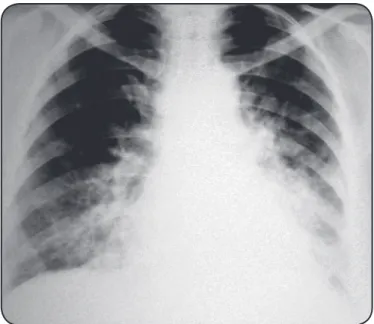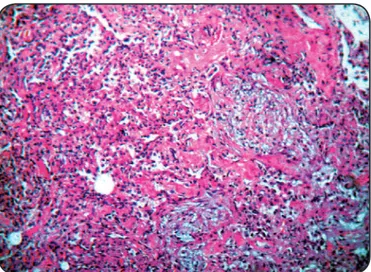655
Address to: Dr. Ronaldo Soares Martins. Serviço de Gastroenterologia/HFR. Av. do Contorno 9530, 30110-934 Belo Horizonte, MG, Brasil.
Phone: 55 31 3514-7190; 55 31 3514-7499 e-mail: ronaldom1@ig.com.br Received in 05/04/2011 Accepted in 12/01/2012
INTRODUCTION
CASE REPORT
Secondary bronchioliis obliterans organizing pneumonia during
treatment of chronic hepaiis C: role of pegylated interferon alfa-2a
Ronaldo Soares Marins
[1],[2], Juliano Antunes Machado
[1],[2]and Rosângela Teixeira
[2],[3][1]. Serviço de Gastroenterologia, Hospital Felício Rocho, Belo Horizonte, MG. [2]. Insituto Alfa de Gastroenterologia, Hospital das Clínicas, Universidade Federal de Minas Gerais, Belo Horizonte, MG. [3]. Departamento de Clínica Médica, Faculdade de Medicina, Universidade Federal de Minas Gerais, Belo Horizonte, MG.
ABSTRACT
The treatment of chronic hepaiis C has frequent side efects such as cytopenias and neuropsychiatric symptoms. However, pulmonary toxicity associated with interferon is rarely described. This paper describes the clinical case of a 67-year-old female paient with chronic hepaiis C who presented an acute onset of dry cough, dyspnoea, and fever 36 weeks ater the use of pegylated interferon alfa-2a and ribavirin. The lung biopsy conirmed the diagnosis of a bronchioliis obliterans organizing pneumonia (BOOP). Coricotherapy was iniiated, with clinical and radiological improvement. This paper aims to advise physicians to this occasional, though severe, adverse event related to hepaiis C virus (HCV) treatment.
Keywords: Pegylated interferon alfa-2a. Bronchioliis obliterans organizing pneumonia. Hepaiis C.
The current therapy of chronic hepaiis C is pegylated interferon
(PEG-IFN) alfa-2a or -2b and ribavirin (RBV)¹. The most common
side efects of interferons are cytopenias and depression. Severe
pulmonary toxicity of interferons has been rarely described. Due to
the increase in the use of this medicaion in the treatment of chronic
hepaiis C, this paper aims at alering physicians to the possibility of
this occasional, though severe, adverse event during the treatment
of chronic hepaiis C.
An asymptomaic 67-year-old white woman with chronic hepaiis C (genotype 1b, liver biopsy Metavir A1F3) was referred to a treatment with PEG-IFN alfa-2a and RBV. She was not under any medicaion and denied tobacco addiction or alcohol abuse. Pre-treatment evaluaion did not reveal any signiicant comorbidity. Hepaiis C virus (HCV) treatment with PEG-IFN alfa-2a (180mcg/week/SC) and RBV (1,250mg/kg/day, PO) was introduced. The iniial tolerance was saisfactory, with only mild side efects of anemia (Hb = 9.9g/dL) and neutropenia (white blood count = 3,100/mm3).
On the 36th week of treatment, the paient was referred to the
hospital with a 5-day history of cough, malaise, and mild fever. Her physical exam revealed bilateral basal coarse crackles. No signiicant abnormality was noted in the complete blood count. The chest radiograph showed heterogeneous opacification bibasilar and paracardiac (Figure 1). HCV treatment was interrupted, and oral levoloxacin (500mg/day) was started. As the symptoms gradually worsened despite the use of levoloxacin, it was empirically replaced by intravenous cetriaxone (2g/24h) and oral azythromycin (500mg/day),
FIGURE 1 -Chest radiograph showing bibasilar and paracardiac heterogeneous opaciicaions.
Revista da Sociedade Brasileira de Medicina Tropical 45(5):655-656, Sep-Oct, 2012
Case Report
and addiional exams were performed. The computed tomography (CT) scan revealed bilateral pulmonary involvement, with ground-glass patern consolidaions. The bronchoalveolar lavage disclosed a purulent discharge. Tests done for Pneumocysis carinii, eosinophils, human immunodeficiency virus (HIV), cytomegalovirus (CMV),
Mycobacterium tuberculosis, Mycobacterium pneumoniae, Legionella
pneumophila, and fungus revealed negaive results. The transthoracic
pulmonary biopsy revealed intersiial iniltrate of mononuclear cells, presence of plugs formed by loose ibrous issue illing alveoli (Masson bodies), and pulmonary ibrosis, which are strongly suggesive of bronchioliis obliterans organizing pneumonia (BOOP) (Figure 2). Oral prednisone (1mg/kg) was promptly administered, with rapid clinical improvement. She was discharged completely recovered ater 22 days of admission, with tapering dose of prednisone to complete, which was withdrawn ater six months.
656
Marins RS et al - BOOP and treatment of chronic hepaiis C
REFERENCES
FIGURE 2 -Lung biopsy with ibrosis and intersiial iniltrate of mononuclear cells and alveoli illed by plugs of loose ibrous issue (Masson bodies) (H&E, x100).
DISCUSSION
BOOP is a cryptogenic or secondary nonspeciic response to
lung injury with high morbidity. Rare, but severe cases of organizing
pneumonia (OP) or BOOP during treatment of chronic hepaiis C have
been reported since 1994
1-3.
The occurrence of BOOP secondary to PEG-IFN alfa-2a is strongly
suggested here, given the nonexistence of other factors to jusify its
occurrence. The nonspeciic symptoms delayed the rapid diagnosis.
However, the disappoining response to quinolones alerted to BOOP.
In addiion, the pulmonary biopsy indings, as well as the notable
response to prednisone, conirmed the diagnosis.
This is the irst descripion of BOOP related to PEG-IFN alfa-2a.
It has been reported that interferons can deregulate the synthesis
of the endothelial growth factor and the matrix metalloproteinase
4,
thus acing as a predisposing factor to the development of BOOP.
Moreover, the immunological and pharmacokineic properies of
PEG-IFN alfa-2a, with the longest half-life, might act in conjuncion
to trigger the pathophysiologic mechanism of BOOP
5-6. Although the
co-administraion of RBV does not afect the pharmacokineics of
PEG-IFNs, these drugs altogether have enhanced toxicity
5. Hence,
it is plausible to suppose that combined drugs might have superior
pulmonary toxicity. However, further studies are needed to conirm
it. The fact that reports of pneumonia or BOOP associated with
ribavirin monotherapy have not been published so far enhances
the likelihood of BOOP induced by pegylated interferon in the case
described in this report.
Regardless of the addiional eicacy and safety of PEG-IFN, which
is largely used in combinaion with RBV to treat chronic hepaiis C,
we reported here a case of BOOP related to PEG-IFN alfa-2a, alering
physicians to this pulmonary nonspeciic side efect with potenial
severity, given the scarcity of publicaions concerning this risk during
the treatment of chronic hepaiis C.
1. Ogata K, Koga T, Yagawa K. Interferon-related bronchioliis obliterans organizing pneumonia. Chest 1994; 106:612-613.
2. Abi-Nassif S, Mark EJ, Fogel RB, Hallisey Jr RK. Pegylated interferon and ribavirin-induced intersiial pneumoniis with ARDS. Chest 2003; 124:406-410. 3. Suga M, Iyonaga K, Okamoto T. Characterisic elevaion of matrix metalloproteinase
acivity in idiopathic intersiial pneumonias. Am J Respir Crit Care Med 2000; 162:1949.
4. Vila JCT, López DRP, Company VB, Simón SS, Hausmann PC, Company JB. Organizing pneumonia associated with the use of pegylated interferon alfa. Arch Bronconeumol 2008; 44:173-174.
5. Zeuzem S, Welsh C, Herrman E. Pharmacokineics of peginterferons. Semin Liver Dis 2003; 23:28.
6. Slavenburg S, Heijdra YF, Drenth JPH. Pneumoniis as a Consequence of (Peg) Interferon-Ribavirin Combination Therapy for Hepatitis C: a Review of the Literature. Dig Dis Sci 2010; 55:579-585.
Bronquiolite obliterante com pneumonia em organização durante o tratamento da hepaite crônica C:
papel do interferon peguilado alfa-2a
O tratamento da hepaite C crônica apresenta efeitos colaterais frequentes como citopenias e sintomas neuropsiquiátricos. Contudo, a toxicidade pulmonar associada ao interferon é raramente descrita. Relatamos o caso de uma paciente com 67 anos que apresentou início agudo de tosse, dispnéia e febre após 36 semanas de uso do interferon peguilado alfa-2a e ribavirina. A biópsia pulmonar conirmou o diagnósico de bronquiolite obliterante com pneumonia em organização, com signiicaiva melhora clínico-radiológica após insituída a coricoterapia. Este relato de caso visa alertar os médicos para a possibilidade desse ocasional, embora grave, evento adverso associado ao tratamento da hepaite C.
Palavras-chaves: Interferon peguilado alfa-2a. Bronquiolite obliterante com pneumonia organização. Hepaite C.

